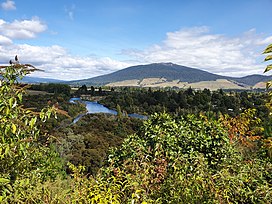Pihanga
| Pihanga | |
|---|---|
 | |
| Highest point | |
| Elevation | 1,326 m (4,350 ft) |
| Coordinates | 39°02′29″S 175°46′07″E / 39.04139°S 175.76861°ECoordinates: 39°02′29″S 175°46′07″E / 39.04139°S 175.76861°E |
| Geography | |
 Pihanga | |
Mount Pihanga is a 1,326 metres (4,350 ft)[1] volcanic peak in the North Island Volcanic Plateau, located to the north of Mount Tongariro, between Tongariro and Lake Taupo. Lake Rotoaira lies to the south-west of Pihanga, and the smaller Lake Rotopounamu is situated on the south-western flank of the volcano, near Te Ponanga Saddle. Mt. Pihanga and Lake Rotopounamu are part of the 5,129ha Pihanga Scenic Reserve, which in 1975 was added to the Tongariro National Park. Mt. Pihanga appears to have a large crater, but this is in fact the result of erosion, and the "crater" quickly narrows into a steep gorge.
Maori mythology[]
In Maori mythology, Pīhanga was the female mountain whom Taranaki and Tongariro fought over, at a time when Taranaki was also located among the central North Island mountains. Tongariro's victory resulted in Taranaki's banishment to the west coast, with his movement creating features such as the Whanganui and Pātea Rivers, and the Ngaere swamp.
The Keepers of the Wai[]
In Maori custom, the Pihanga Maunga became the responsibility of the Matapuna people (a mix of Tuwharetoa, Tama Kopiri/Upper Whanganui whanau/Tu Hope - Descendants of Te Rere Ao, the First of Tuwharetoa) of the Tuwharetoa people, who have traditionally been the keepers of the wai (Keepers of the Water) and Maunga Kaitiaki (Protectors of the Mountain). The Pihanga mountain was an important water resource for the whole of the Tuwharetoa, Tainui, Whanganui and some parts of the East Coast rohe, are all catchments of this water source.
Some members of the chieftain line of the Matapuna people, who held mana, were given the honor of being buried on the mountain. One such chief, Pakau, interred his son, who was killed in battle, in one of the burial caves. Pakau was known to have mourned for many months over the death of his son.[2]
See also[]
References[]
- ^ Index Mundi: New Zealand: Mountains: Pihanga to Poarangitautahi
- ^ Kahui Maunga Vol. 1 Page 125, Page 126 A history of the Tuwharetoa People
External links[]
- United Nations Environment Programme: Parks and Protected Areas: World Heritage Sites: Tongariro National Park
- Best, Elsdon. The Maori - Volume I, V Myth and Folk Lore. p205.
- Peter Thomson: Walks, GPS Tracks and many photographs: New Zealand: Rotopounamu
- Volcanoes of Waikato
- Tongariro Volcanic Centre
